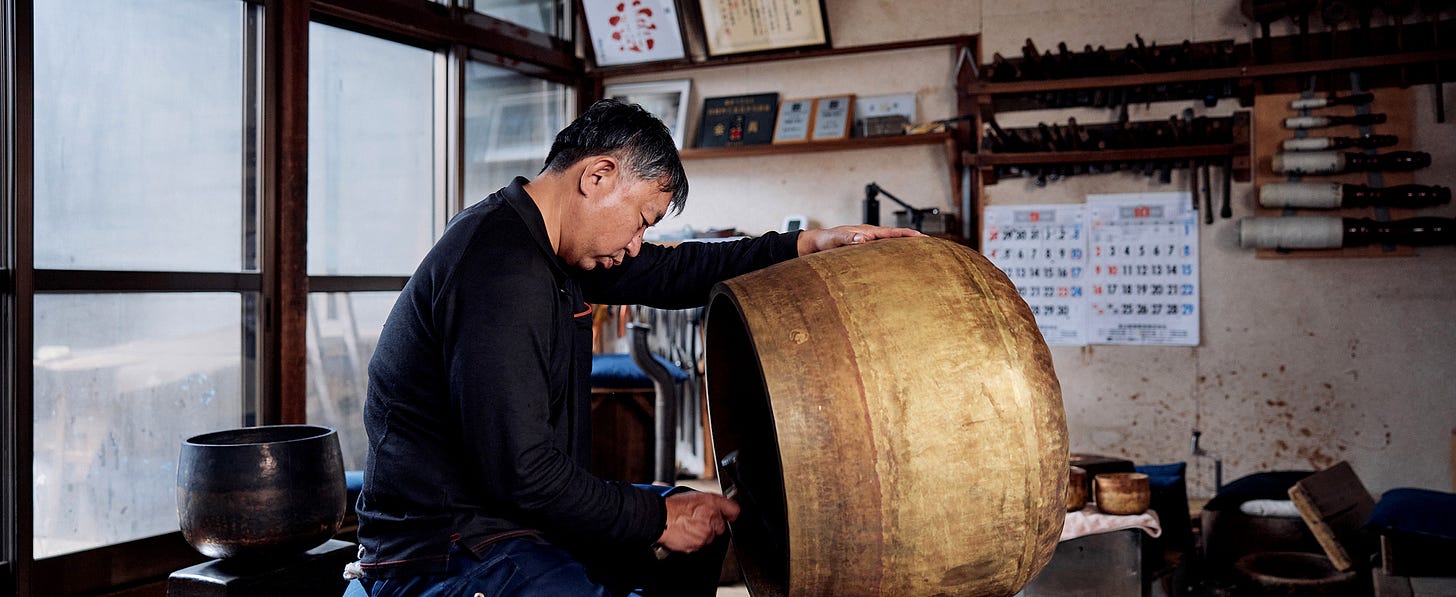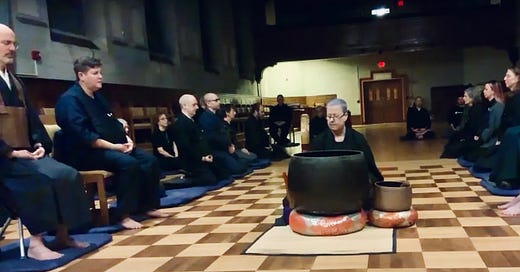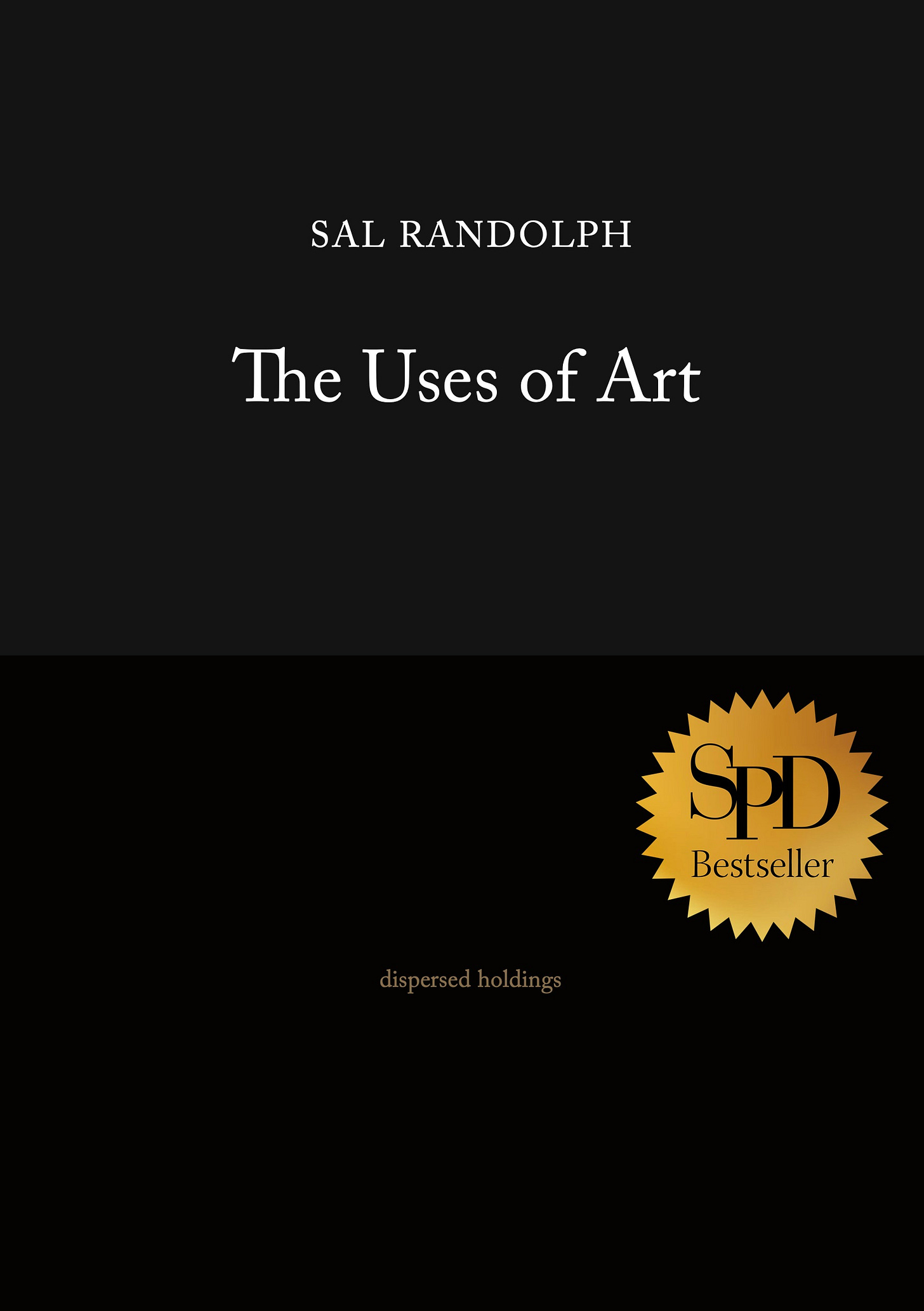Dear Friends,
During the Village Zendo’s recent winter retreat I had the role of bell ringer, or doan (pronounced in two syllables: doh-ahn).
The doan rings the bell many times a day, and also on New Year’s Eve during the ceremony of the 108 bells. I had to learn both how to hit the bell and when to hit the bell. The bell itself became a friend and teacher.
In this talk I tell the story of our large bell and what it teaches about time.
— Sal (Gessho)
Video: Sounding the Bell
Podcast
As an alternative, you can listen to the podcast version of this talk here.
Transcript: Sounding the Bell
I want to talk to you about a bell.
For those of you who are here with me in the zendo, it’s right over there, at the back of the room, and you probably know it well. We call it the big keisu, and for years I thought people were saying the English language word “case” as in something you put things inside. I had no idea why it was called that, but so much was new for me at the zendo that I just accepted it as a mystery. I think I had confidence that I would come to understand this, and various other mysteries that I encountered. And indeed, this has come to pass.
What people were saying was actually the Japanese word keisu. Which in the English alphabet would be spelled k-e-s-u or k-e-i-s-u. It’s just that in Japanese, the “u” is hardly voiced and mostly silent.
For those of you who are not in the presence of this bell or who have never seen it, it is shaped like a bowl. It is what is sometimes called an upright, or standing bell, because the mouth points up. It sits on a cushion. It’s a big bowl. The top rim is about the same size as the circle of my arms, and the belly is larger. If you are up next to it, it feels even bigger, as if it were a kind of person.
Our big keisu was found in Japan by Enkyo Roshi, who bought it for the zendo and dedicated it as a memorial to her teacher Maezumi Roshi. It has an inscription to Maezumi Roshi on the rim.
It is made in the traditional manner, from three sheets of bronze that are fused together: the base, the body, and the rim. If you look inside the bell, you can see the seams. These bells are shaped by a process of heating, cooling, and hammering to anneal the metal. It takes about forty rounds of this, which happens over several months. Then process of tuning begins. The bell-maker rings the bell, listens, and then strikes it with a wooden hammer to adjust the sound.
Right now, there are only ten people in Japan who know how to make these bells in the traditional way. One of them, Yoshinori Shimatani, described apprenticing to his grandfather in the studio that makes bells for Eiheiji temple among others. Shimatani spent five years just listening to his grandfather tune bells before he was allowed to pick up a hammer himself. Each size of bell is tuned differently, and he had to learn from memory the right sounds for each kind of bell. Then he spent another five years gradually learning the techniques under his grandfather’s supervision, and another two years of practice before his grandfather handed over the tradition.
During the tuning, the sound is adjusted to create slow undulations in three parts that are named kan, otsu, and mon. The kan is the first striking sound, the otsu he describes as “a higher vibrating tone,” and the mon as “a slower, billowing sound.”
These bells are also known in Japan as rin bells, or orin — the “o” is an honorific, as if you were speaking of a respected person. Shimatani said: “I think of my orin as my children. For the few months that I am shaping them, I am pouring myself and all my emotions into them. So, my mental state is very important as I work.”
Our bell has a beautiful, billowing sound.
I know this, and I’m telling you about this bell, because I spent a week with it on our recent retreat. I was the doan or bell-ringer, and I rang this bell many times every day.
When I sat down next to it at the beginning of the week, this bell was something I had hardly ever touched, but by the end of the week it was something like an intimate friend or perhaps more like a teacher.
There’s a famous koan about a bell that goes like this:
Yunmen said, “The world is vast and wide, why do you put on your priest’s robe at the sound of the bell?”
We could think of this koan in several ways.
One way is that, like many koans, this story is pointing to the fundamental point of what we do. We could be doing anything with our lives, in our lives, but somehow a number of us have gathered here this evening at the zendo, and others have taken time out of their day to join online, or listen to this in the future. The world is vast and wide. Why are we doing this?
What is the point of sitting zazen, of listening to a dharma talk, of following the buddha way?
Another aspect of this koan, one that I want to focus on tonight, is the aspect of time. As everyone listening probably knows by now, our study text for this period is Dogen’s Uji, or Time Being.
One of the central points of Uji is that we ourselves are time, and in fact everything is time. For me, this has the same trippy quality as the opening lines of the heart sutra when Avalokitesvara tells Shariputra what they have realized during meditation: that form is no other than emptiness, emptiness no other than form. Form is exactly emptiness, emptiness exactly form. I often look at something during that line: the floor, a person’s foot, and try to bring this into my awareness: that thing, which looks like form to me, is exactly emptiness.
To say that everything is time is really no different than to say form is emptiness.
Here’s where Dogen says that we ourselves are time:
The way the self arrays itself is the form of the entire world. See each thing in this entire world as a moment of time. Things do not hinder one another, just as moments do not hinder one another. The way-seeking mind arises in this moment. A way-seeking moment arises in this mind. It is the same with practice and with attaining the way. Thus the self setting itself out in array sees itself. This is the understanding that the self is time.
Ryoshin Hoshi also read this passage in a recent talk, and I think it goes to the heart of Uji.
The way the self arrays itself is the form of the entire world. See each thing in this entire world as a moment of time. … Thus the self setting itself out in array sees itself. This is the understanding that the self is time.
Let’s think about Yunmen again:
Yunmen said, “The world is vast and wide, why do you put on your priest’s robe at the sound of the bell?”
If the way the self arrays itself is the form of the entire world, if each thing in this world is a moment in time, why do we put on our robes at the sound of the bell?
The world is not frozen in some timeless state, it exists moment by moment, we exist moment by moment. We wake up in the morning, we eat, we do the work of the day, and when it’s time to come to the zendo we come to the zendo. It’s time for me to be giving this talk, and I’m giving this talk. This talk. These words. This moment.
Dogen reminds us that this moment does not hinder any other moment, and in fact each thing and each moment contains everything else.
Know that in this way there are myriads of forms and hundreds of grasses throughout the entire earth, and yet each grass and each form itself is the entire earth. The study of this is the beginning of practice. When you are at this place, there is just one grass, there is just one form; there is understanding of form and no-understanding of form; there is understanding of grass and no-understanding of grass. Since there is nothing but just this moment, the time-being is all the time there is. Grass-being, form-being are both time. Each moment is all being, is the entire world. Reflect now whether any being or any world is left out of the present moment.
Is there anything left out of this moment right here?
I want to come back to the bell I was talking about at the beginning.
As I mentioned, my service position on retreat was to be the doan or bell ringer. I had wanted to learn this role for years, so I was very grateful for the opportunity.
I really had no experience with the bell, so the beginning was a little rough. Sometimes I was too loud, sometimes too soft. I tried several ways of holding the striker until I found one that felt right, but even then I received advice to hold it a different way. And the timing was its own difficulty. The bell has to be struck at just the right moment, many many times during the day. Many many right moments.
The world is vast and wide, why do I strike the bell when the officiant bows? The world is vast and wide, why do I strike the bell when the ino sings the name of the chant: Maha Prajna Paramita Heart Sutra-a-a. Gong.
The bell teaches something about time. Something I can’t put into words. The bell is silent until you strike it. Then it responds to the motion of your arm, and that motion is the motion of your entire being. The sounding of the bell begins with that strike but it keeps reverberating for a long time.
Yoshinori Shimatani said the largest bells, like the one at Eiheji, can ring for as long as ten minutes. Sometimes, when I rang our bell, it felt like the reverberations went out into space and time forever..
Last year, around this time, Fusho Hoshi gave a talk called “Inviting the bell to ring.” She took the phrase from Thich Nhat Hanh, who said, “Usually, when someone sounds the bell, we don’t say ‘hit’ it, we say that they should ‘invite the bell to sound’.”
In Thich Nhat Hanh’s tradition, the bell ringer prepares themselves with a short verse as before they invite the bell to sound. It goes:
Body, speech, and mind in perfect oneness. I send my heart along with the sound of this bell. May the hearers awaken from their forgetfulness and transcend the path of anxiety and sorrow.
And then when the bell sounds, you say to yourself as you breathe in:
“I listen, I listen.” And when you breathe out, you say: “Listen, listen. This wonderful sound brings me back to my true home.”
I’d like to ask our doan to ring the bell for us so we can say that to ourselves.
“Listen, listen. This wonderful sound brings me back to my true home.”
In closing, I want to go back to Dogen. He says: Since there is nothing but just this moment, the time-being is all the time there is.
I think it’s easy to feel that when you really listen to the sound of the bell. Ringing the bell gives you a special opportunity to feel now, now, now.
Is there anything left out of this moment right here?
In one of his other essays, Dogen offers a poem from his teacher, Rujing, who is speaking of a wind-bell.
The entire body is a mouth hanging in empty space, regardless of the wind from the east, west, south, or north, joining the whole universe in chiming out prajna. Ting-ting, ting-ting, ting-ting.
Now-now, now-now, now-now
More Information
108 Bells
The Village Zendo’s 108 bells ceremony.
Yoshinori Shimatani

Shimatani Shoryu’s Singing Bowls
Yoshinori Shimatani talk and demonstration.
About Shimatani Shouryu Studio
How to Be More Zen, From One of Japan’s Last Remaining Buddhist Bell-Makers
Thich Nhat Hanh
Eihei Dogen
Further adventures and new ways of seeing can be found in my book, The Uses of Art.
Artist Sal Randolph’s THE USES OF ART is a memoir of transformative encounters with works of art, inviting readers into new methods of looking that are both liberating and emboldening.
Dazzlingly original, ferociously intelligent.
— Michael Cunningham
A joyful, dazzling treasure-box of a book.
— Bonnie Friedman
Here’s a guide, to waking up, over and over again.
— Roshi Pat Enkyo O’Hara







I so loved reading this, even after hearing your beautiful talk. So helpful, and exquisite. Thank you.
I love that bell...thanks for this.